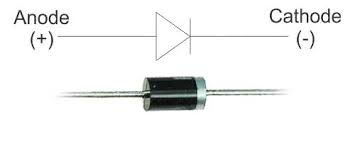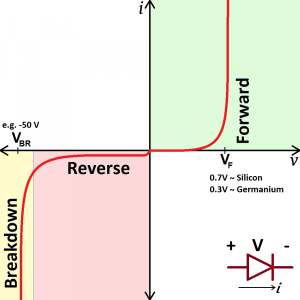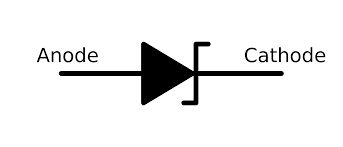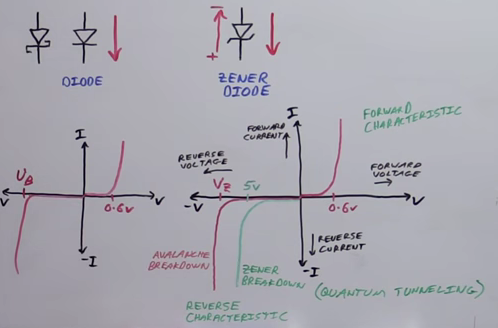Overview
The key function of an ideal diode is to control the direction of current-flow. Current passing through a diode can only go in one direction, called the forward direction. Current trying to flow the reverse direction is blocked. They’re like the one-way valve of electronics.
Depending on the voltage applied across it, a diode will operate in one of three regions:
- Forward bias: When the voltage across the diode is positive the diode is “on” and current can run through. The voltage should be greater than the forward voltage (VF) in order for the current to be anything significant.
- Reverse bias: This is the “off” mode of the diode, where the voltage is less than VF but greater than -VBR. In this mode current flow is (mostly) blocked, and the diode is off. A very small amount of current (on the order of nA) – called reverse saturation current – is able to flow in reverse through the diode.
- Breakdown: When the voltage applied across the diode is very large and negative, lots of current will be able to flow in the reverse direction, from cathode to anode.
Types of Diodes
Normal Diodes
| Type | Forward Voltage | Max Forward Current | Example Diode | Image |
|---|---|---|---|---|
| Signal Diode | 0.7v | 300 mA | 1N4148 | |
| Power Diode | 1.1v | 1A | 1N4001 |
Schottky Diodes
Schottky diodes are like regular diodes but with smaller forward voltage drop which is usually between 0.15V and 0.45V. They’ll still have a very large breakdown voltage though. Schottky diodes are especially useful in limiting losses, when every last bit of voltage must be spared.
Zener Diodes
Zener diodes can conduct current in both directions. Zener’s are designed to have a very precise breakdown voltage, called the zener breakdown or zener voltage. When enough current runs in reverse through the zener, the voltage drop across it will hold steady at the breakdown voltage.
Taking advantage of their breakdown property, Zener diodes are often used to create a known reference voltage at exactly their Zener voltage. They can be used as a voltage regulator for small loads, but they’re not really made to regulate voltage to circuits that will pull significant amounts of current.
References
| Reference | URL |
|---|---|
| Diodes - Sparkfun | https://learn.sparkfun.com/tutorials/diodes |
| Zener Diodes | http://www.electronics-lab.com/zener-diodes-theory-practice/ |
| Wikipedia - Zener Diode | https://en.wikipedia.org/wiki/Zener_diode |






